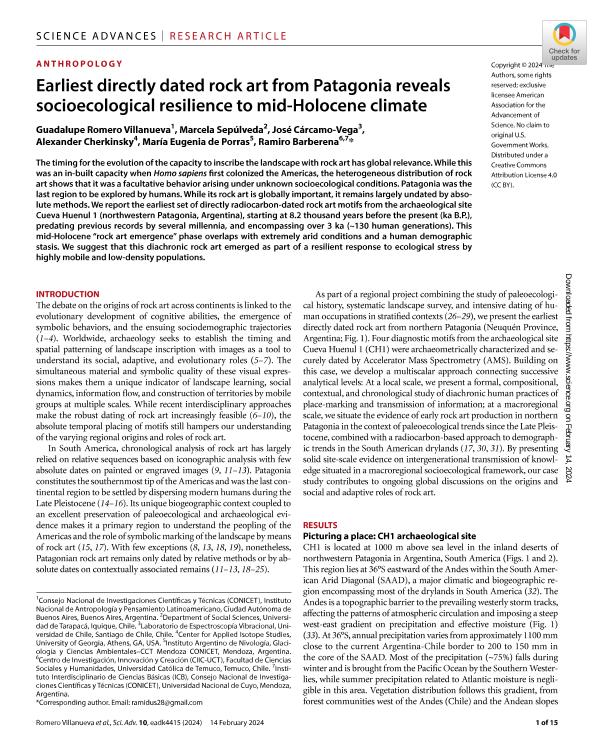Artículo
Earliest directly dated rock art from patagonia reveals socioecological resilience to mid-Holocene climate
Romero Villanueva Badin, Guadalupe ; Sepúlveda, Marcela; Cárcamo Vega, José; Cherkinsky, Alexander; de Porras, Maria Eugenia
; Sepúlveda, Marcela; Cárcamo Vega, José; Cherkinsky, Alexander; de Porras, Maria Eugenia ; Barberena, Ramiro
; Barberena, Ramiro
 ; Sepúlveda, Marcela; Cárcamo Vega, José; Cherkinsky, Alexander; de Porras, Maria Eugenia
; Sepúlveda, Marcela; Cárcamo Vega, José; Cherkinsky, Alexander; de Porras, Maria Eugenia ; Barberena, Ramiro
; Barberena, Ramiro
Fecha de publicación:
02/2024
Editorial:
Science Advances is the American Association for the Advancement of Science
Revista:
Science Advances
ISSN:
2375-2548
Idioma:
Inglés
Tipo de recurso:
Artículo publicado
Clasificación temática:
Resumen
The timing for the evolution of the capacity to inscribe the landscape with rock art has global relevance. While this was an in-built capacity when Homo sapiens first colonized the Americas, the heterogeneous distribution of rock art shows that it was a facultative behavior arising under unknown socioecological conditions. Patagonia was the last region to be explored by humans. While its rock art is globally important, it remains largely undated by absolute methods. We report the earliest set of directly radiocarbon-dated rock art motifs from the archaeological site Cueva Huenul 1 (northwestern Patagonia, Argentina), starting at 8.2 thousand years before the present (ka B.P.), predating previous records by several millennia, and encompassing over 3 ka (~130 human generations). This mid-Holocene “rock art emergence” phase overlaps with extremely arid conditions and a human demographic stasis. We suggest that this diachronic rock art emerged as part of a resilient response to ecological stress by highly mobile and low-density populations.
Archivos asociados
Licencia
Identificadores
Colecciones
Articulos(IANIGLA)
Articulos de INST. ARG. DE NIVOLOGIA, GLACIOLOGIA Y CS. AMBIENT
Articulos de INST. ARG. DE NIVOLOGIA, GLACIOLOGIA Y CS. AMBIENT
Articulos(ICB)
Articulos de INSTITUTO INTERDISCIPLINARIO DE CIENCIAS BASICAS
Articulos de INSTITUTO INTERDISCIPLINARIO DE CIENCIAS BASICAS
Articulos(SEDE CENTRAL)
Articulos de SEDE CENTRAL
Articulos de SEDE CENTRAL
Citación
Romero Villanueva Badin, Guadalupe; Sepúlveda, Marcela; Cárcamo Vega, José; Cherkinsky, Alexander; de Porras, Maria Eugenia; et al.; Earliest directly dated rock art from patagonia reveals socioecological resilience to mid-Holocene climate; Science Advances is the American Association for the Advancement of Science; Science Advances; 10; 7; 2-2024; 1-15
Compartir
Altmétricas



